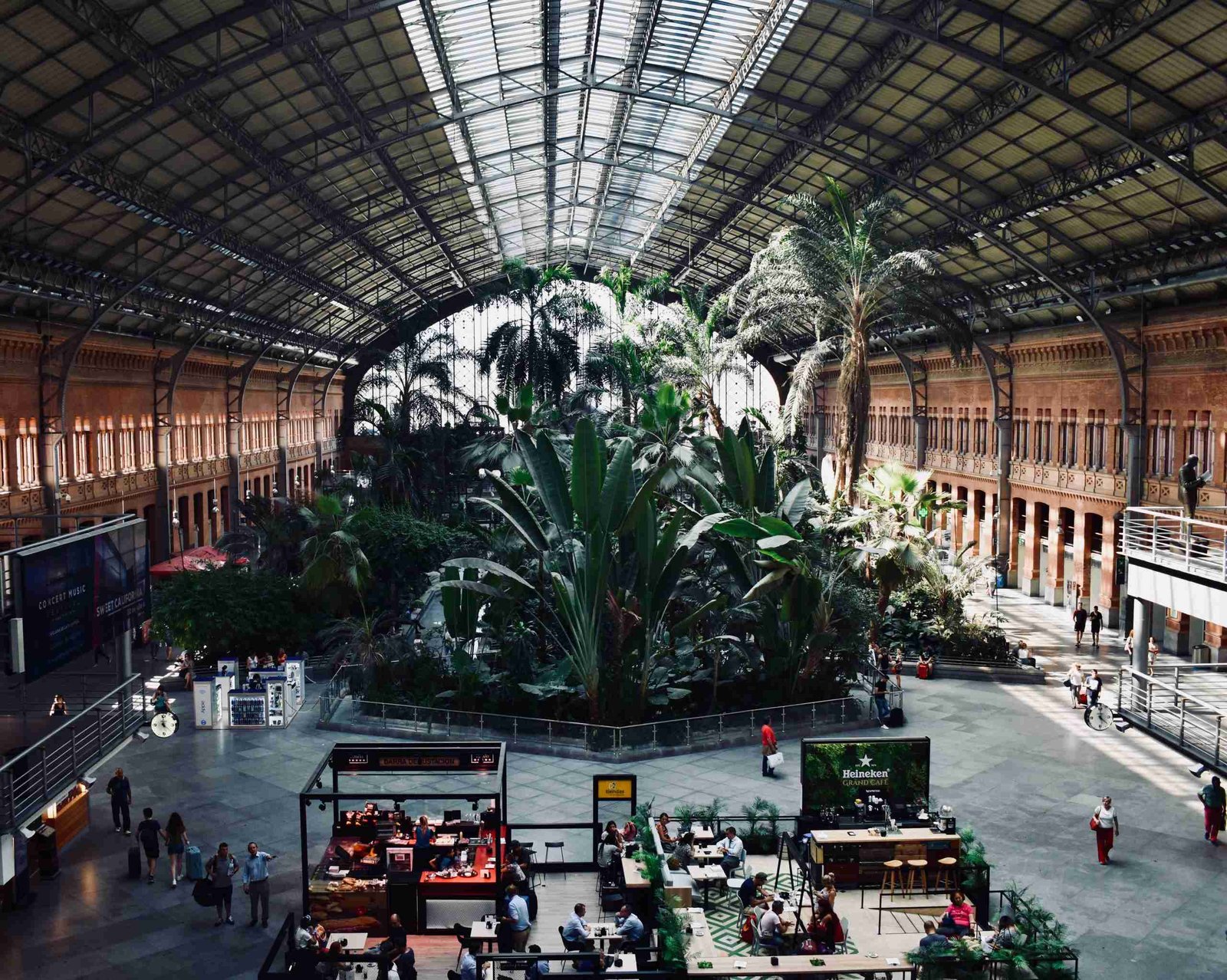

Transportation in Madrid
1. Madrid Metro system
Getting around Madrid is a breeze, thanks to the efficient and extensive Madrid Metro system. With over 300 stations and 13 lines, the metro is the ideal way to navigate the city. The trains are frequent, clean, and easy to use, and the metro covers all major attractions and neighborhoods in Madrid. You can purchase a single trip ticket or a rechargeable contactless card known as the “Tarjeta Multi,” which offers convenience and discounted fares for multiple journeys.
2. Buses and bus routes
If you prefer to see the city above ground, the extensive bus network in Madrid is another excellent transportation option. The buses cover areas not reached by the metro and provide a scenic way of exploring the city. You can find bus stops located throughout Madrid, and there are different types of buses available, including regular buses, express buses, and night buses for those looking to travel after hours. The bus routes are well-marked and offer a convenient and affordable way to get around Madrid.
3. Taxis and ride-sharing services
For a more comfortable and convenient ride, you can opt for taxis or ride-sharing services in Madrid. Taxis are readily available throughout the city and can be hailed on the street or found at designated taxi stands. Ride-sharing services like Uber and Cabify also operate in Madrid, offering an alternative to traditional taxis. These services can be booked through smartphone apps and provide a reliable and convenient mode of transportation, especially for longer journeys or when traveling with a group.
No matter which mode of transportation you choose in Madrid, you can expect a well-connected and efficient system that makes getting around the city a breeze. With the options available, you can easily explore all that Madrid has to offer. So sit back, relax, and enjoy your journey through this vibrant Spanish capital!

Exploring Madrid on Foot
1. Must-visit landmarks and attractions
When exploring Madrid on foot, there are several must-visit landmarks and attractions that you should not miss. Some of the top highlights include the Royal Palace, which is the largest working palace in Europe, and the Prado Museum, home to an impressive collection of Spanish masterpieces. Additionally, take a stroll through the bustling Plaza Mayor, marvel at the grandeur of the Puerta del Sol, and explore the beautiful Retiro Park.
2. Walking tours and routes
To make the most of your time exploring Madrid on foot, consider joining a walking tour. There are various guided tours available that cover different areas and themes such as the historic city center, food and wine, and street art. Alternatively, you can create your own walking route by using a map or smartphone app to navigate the city's streets and neighborhoods at your own pace.
3. Safety tips for pedestrians
While walking around Madrid, it is important to prioritize your safety. Some tips to keep in mind include:
- Observe traffic signals and pedestrian crossings.
- Stay alert and aware of your surroundings, especially in crowded areas.
- Keep your belongings secure and be mindful of pickpockets.
- Wear comfortable shoes and stay hydrated, especially during hot weather.
- Use well-lit and busy streets, especially at night.
By following these safety tips and exploring Madrid on foot, you can immerse yourself in the city's vibrant culture, discover hidden gems, and truly experience the charm of this beautiful Spanish capital.

Renting a Bicycle in Madrid
1. Bike rental services
Renting a bicycle is a great way to explore Madrid and experience the city like a local. There are several bike rental services available in Madrid that offer a variety of options to suit your needs. Some popular bike rental services include Bike Spain, Rent & Roll, and BiciMAD, which is a public bike sharing system.
These bike rental services offer various types of bicycles, including city bikes, mountain bikes, and electric bikes. They also provide helmets, locks, and other accessories to ensure your safety and convenience.
2. Recommended cycling routes
Madrid offers numerous scenic and well-maintained cycling routes that cater to different preferences and skill levels. One of the most popular routes is the Madrid Rio Cycle Path, which follows the Manzanares River and provides stunning views of the city. Another recommended route is the Casa de Campo Park, a vast green area with flat trails and beautiful landscapes.
For more adventurous cyclists, the Sierra de Guadarrama National Park offers challenging mountain bike trails amidst breathtaking natural surroundings.
3. Rules and regulations for cycling in the city
When cycling in Madrid, it's important to familiarize yourself with the rules and regulations to ensure a safe and enjoyable experience. Cyclists are required to wear helmets, obey traffic rules, and use designated cycling lanes whenever possible.
It's also essential to be aware of pedestrians and other vehicles on the road, especially in busy areas. Additionally, remember to lock your bike securely when not in use to prevent theft.
Exploring Madrid on a bicycle not only allows you to navigate the city easily but also provides a unique way to discover hidden gems and soak in the vibrant atmosphere. So, grab a bike and start pedaling your way through the beautiful streets of Madrid!

Using Public Transportation Cards
Are you planning a trip to Madrid? One of the best and most convenient ways to get around the city is by using public transportation. And the key to a hassle-free experience is by using public transportation cards.
1. Types of cards available
Madrid offers various types of transportation cards that cater to different needs. The most commonly used cards are:
-
Abono Transporte: This card is ideal for commuters or frequent travelers. It allows unlimited travel on all modes of public transportation within specific zones and for a selected duration.
-
Tarjeta Multi: This card is ideal for occasional travelers or tourists. It can be loaded with a specific amount of money and used for individual trips on buses, metro, and trains.
2. How to obtain and recharge cards
You can obtain and recharge transport cards at any metro station or authorized points of sale. To get a card, simply fill out an application form, provide a photo ID, and pay the initial fee. Once you have the card, you can recharge it at ticket offices, machines, or online.
3. Tips for using public transportation efficiently
-
Plan your route using the official website or mobile apps to find the fastest and most convenient options.
-
Keep an eye on the transportation schedule to avoid any inconvenience.
-
Avoid peak hours when possible, especially during morning and evening rush hours.
-
Validate your card by touching it on the card readers upon entering and exiting the transportation facilities.
-
Take advantage of the integrated transportation network by transferring between metro, buses, and trains using the same card.
With a reliable public transportation system and the convenience of transport cards, getting around Madrid has never been easier. Enjoy your travels and explore the vibrant city with ease!

Day Trips from Madrid
Planning a day trip from Madrid? Look no further! With its central location and excellent transportation options, Madrid makes a great base for exploring the surrounding towns and cities. Here are some tips to help you navigate and make the most of your day trips.
1. Excursions to nearby towns and cities
Madrid is surrounded by charming towns and cities that are perfect for day trips. Some popular options include:
- Toledo: Known as the “City of Three Cultures,” Toledo is a UNESCO World Heritage Site with its mix of Christian, Jewish, and Muslim influences.
- Segovia: Famous for its stunning Roman aqueduct and fairytale-like Alcazar, Segovia is a must-visit destination.
- Avila: Nestled amidst medieval walls, Avila is known for its well-preserved historic center and impressive cathedral.
2. Transportation options for day trips
Getting around Madrid and its surrounding areas is convenient thanks to its extensive transportation network:
- Train: Renfe operates regular trains to various nearby destinations, making it a quick and efficient mode of transport.
- Bus: ALSA and other bus operators offer regular services to nearby towns and cities, providing a more budget-friendly option.
- Car Rental: If you prefer more flexibility and exploration at your own pace, renting a car is a popular choice.
3. Top destinations for day trips
When planning your day trips from Madrid, consider these top destinations:
- El Escorial: Home to the magnificent Royal Monastery of San Lorenzo de El Escorial, this town is a UNESCO World Heritage Site.
- Chinchon: Known for its charming plaza and traditional Spanish architecture, Chinchon offers a taste of rural Spain.
- Aranjuez: Explore the grand Royal Palace and stunning gardens in this historic town.
Remember to check the schedules, purchase tickets in advance when necessary, and make the most of your day exploring these fantastic destinations around Madrid!

Safety Tips for Getting Around Madrid
1. Avoiding pickpockets and scams
When getting around Madrid, it's important to stay vigilant and protect yourself from pickpockets and scams. Here are some tips to keep in mind:
-
Keep your belongings secure: Use a cross-body bag or backpack instead of carrying a purse that can be easily snatched. Keep your wallet in a front pocket or in a secure money belt.
-
Be aware of your surroundings: Stay alert in crowded areas, especially on public transportation and in tourist hotspots. Be cautious of distractions or people getting too close to you.
-
Avoid displaying valuable items: Don't flaunt expensive jewelry or electronics, as it may attract unwanted attention. Keep them out of sight and use caution when taking out your phone or camera.
2. Emergency numbers and services
It's always important to familiarize yourself with emergency numbers and services in any city you visit. In Madrid, the emergency number is 112, which can be dialed for police, medical, or fire emergencies. It's also a good idea to have the contact information for your embassy or consulate in case of any unforeseen circumstances.
3. Staying aware of your surroundings
When navigating Madrid, try to stay aware of your surroundings and make mindful decisions. Here are a few things to consider:
-
Plan your route in advance: Familiarize yourself with maps and transportation schedules to avoid getting lost or ending up in unfamiliar areas.
-
Use reliable transportation: Stick to licensed taxis or public transportation options that have good reviews and are trusted by locals.
-
Ask for help if needed: If you're unsure about something or need assistance, don't hesitate to ask locals or contact tourist information centers.
Remember, your safety is a priority when exploring any city, including Madrid. By following these tips and staying cautious, you can make the most of your experience while keeping yourself protected.

Conclusion
Final tips and recommendations for exploring Madrid efficiently and safely
-
Use public transportation: Madrid has an excellent public transportation system, including metro, buses, and trains. It's affordable, efficient, and a great way to navigate the city.
-
Take advantage of walking: Madrid is a walkable city, with many attractions and neighborhoods easily accessible by foot. Use a reliable map or navigation app to explore the city streets and discover hidden gems along the way.
-
Be mindful of pickpockets: Like in any major city, pickpocketing can be a concern. Keep your belongings secure and be aware of your surroundings, especially in crowded tourist areas.
-
Take a siesta: Embrace the Spanish tradition of the siesta and take a break in the afternoon. Many shops and attractions may close during this time, so plan your day accordingly.
-
Try local cuisine: Madrid is famous for its culinary delights, so make sure to indulge in traditional Spanish dishes such as tapas, paella, and churros. Explore local markets, cafes, and restaurants to savor the flavors of the city.
-
Experience the local culture: Madrid is full of cultural experiences, from visiting world-class museums to attending flamenco shows. Immerse yourself in the vibrant and diverse culture of Madrid to truly appreciate the essence of the city.
-
Plan your itinerary: With so much to see and do in Madrid, it's essential to plan your itinerary in advance. Consider the opening hours of attractions, special events, and allocate enough time to explore each neighborhood thoroughly.
By following these tips and recommendations, you will be able to navigate Madrid efficiently, safely, and make the most out of your visit to this remarkable city. Enjoy your exploration and have an unforgettable experience in Madrid!



